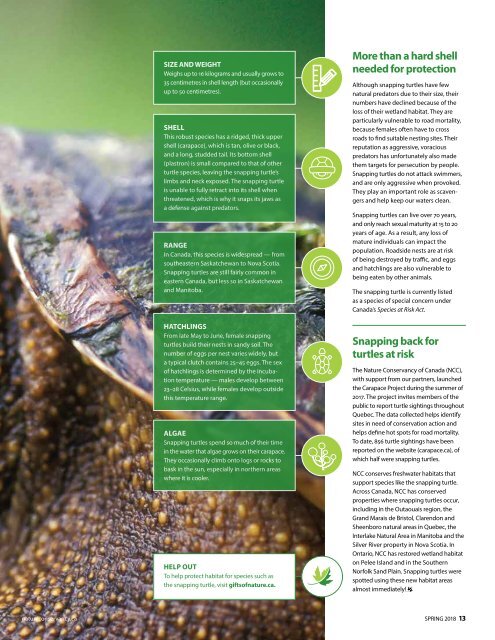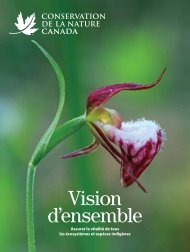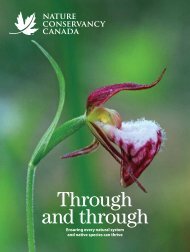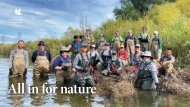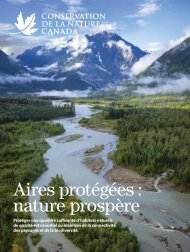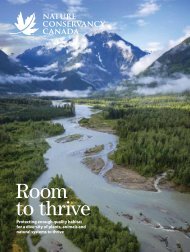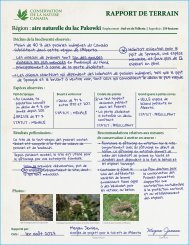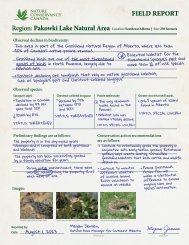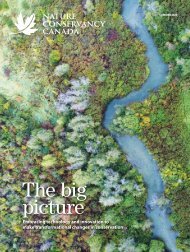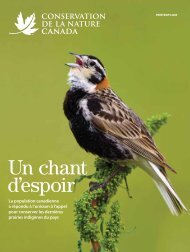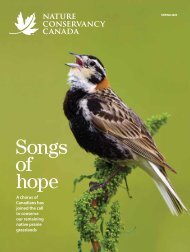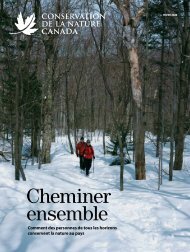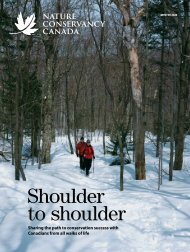Spring 2018 NCC Magazine
Create successful ePaper yourself
Turn your PDF publications into a flip-book with our unique Google optimized e-Paper software.
SIZE AND WEIGHT<br />
Weighs up to 16 kilograms and usually grows to<br />
35 centimetres in shell length (but occasionally<br />
up to 50 centimetres).<br />
SHELL<br />
This robust species has a ridged, thick upper<br />
shell (carapace), which is tan, olive or black,<br />
and a long, studded tail. Its bottom shell<br />
(plastron) is small compared to that of other<br />
turtle species, leaving the snapping turtle’s<br />
limbs and neck exposed. The snapping turtle<br />
is unable to fully retract into its shell when<br />
threatened, which is why it snaps its jaws as<br />
a defense against predators.<br />
RANGE<br />
In Canada, this species is widespread — from<br />
southeastern Saskatchewan to Nova Scotia.<br />
Snapping turtles are still fairly common in<br />
eastern Canada, but less so in Saskatchewan<br />
and Manitoba.<br />
HATCHLINGS<br />
From late May to June, female snapping<br />
turtles build their nests in sandy soil. The<br />
number of eggs per nest varies widely, but<br />
a typical clutch contains 25–45 eggs. The sex<br />
of hatchlings is determined by the incubation<br />
temperature — males develop between<br />
23–28 Celsius, while females develop outside<br />
this temperature range.<br />
ALGAE<br />
Snapping turtles spend so much of their time<br />
in the water that algae grows on their carapace.<br />
They occasionally climb onto logs or rocks to<br />
bask in the sun, especially in northern areas<br />
where it is cooler.<br />
HELP OUT<br />
To help protect habitat for species such as<br />
the snapping turtle, visit giftsofnature.ca.<br />
More than a hard shell<br />
needed for protection<br />
Although snapping turtles have few<br />
natural predators due to their size, their<br />
numbers have declined because of the<br />
loss of their wetland habitat. They are<br />
particularly vulnerable to road mortality,<br />
because females often have to cross<br />
roads to find suitable nesting sites. Their<br />
reputation as aggressive, voracious<br />
predators has unfortunately also made<br />
them targets for persecution by people.<br />
Snapping turtles do not attack swimmers,<br />
and are only aggressive when provoked.<br />
They play an important role as scavengers<br />
and help keep our waters clean.<br />
Snapping turtles can live over 70 years,<br />
and only reach sexual maturity at 15 to 20<br />
years of age. As a result, any loss of<br />
mature individuals can impact the<br />
population. Roadside nests are at risk<br />
of being destroyed by traffic, and eggs<br />
and hatchlings are also vulnerable to<br />
being eaten by other animals.<br />
The snapping turtle is currently listed<br />
as a species of special concern under<br />
Canada’s Species at Risk Act.<br />
Snapping back for<br />
turtles at risk<br />
The Nature Conservancy of Canada (<strong>NCC</strong>),<br />
with support from our partners, launched<br />
the Carapace Project during the summer of<br />
2017. The project invites members of the<br />
public to report turtle sightings throughout<br />
Quebec. The data collected helps identify<br />
sites in need of conservation action and<br />
helps define hot spots for road mortality.<br />
To date, 856 turtle sightings have been<br />
reported on the website (carapace.ca), of<br />
which half were snapping turtles.<br />
<strong>NCC</strong> conserves freshwater habitats that<br />
support species like the snapping turtle.<br />
Across Canada, <strong>NCC</strong> has conserved<br />
properties where snapping turtles occur,<br />
including in the Outaouais region, the<br />
Grand Marais de Bristol, Clarendon and<br />
Sheenboro natural areas in Quebec, the<br />
Interlake Natural Area in Manitoba and the<br />
Silver River property in Nova Scotia. In<br />
Ontario, <strong>NCC</strong> has restored wetland habitat<br />
on Pelee Island and in the Southern<br />
Norfolk Sand Plain. Snapping turtles were<br />
spotted using these new habitat areas<br />
almost immediately!1<br />
natureconservancy.ca<br />
SPRING <strong>2018</strong> 13


